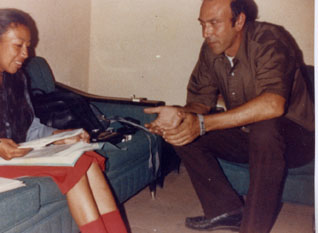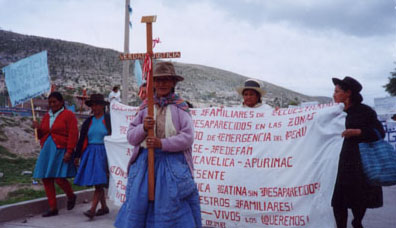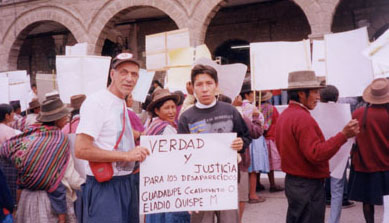 |
The Corner of the Dead: Ayacucho, PeruBy Louis De BenedetteI met Guadalupe Ccallocunto Olano at a mass for peace in Lima, Peru in 1984. She was 24 and the mother of four small children. Her husband, Eladio, was missing, forcibly "disappeared" by the Peruvian military security forces in the Andean city of Ayacucho. Guadalupe was organizing relatives of the disappeared, and she helped found the association of the relatives of the disappeared in Ayacucho (ANFASEP). Later, she became a member of Service for Peace and Justice (SERPAJ), founded by Adolfo P. Esquivel, winner of the 1980 Nobel Peace Prize. SERPAJ was a nonviolent organization that sought to stop the disappearances and assassinations by military forces that were waging a war against the terrorist Maoist group Sendero Luminoso ("Shining Path"). I liked Guadalupe from the moment I met her, and we became friends. She asked me to be the godfather of her children.
I returned to Ayacucho this year to observe the work of a newly-formed truth commission. When I was there in 1984, the military was waging a war against the Shining Path and its leader Abimael Guzman, who was eventually captured in 1992. The group is practically wiped out except for a small contingent in the jungle coca region. However, as Father Neptali Liceta told me, even if there was no Sendero, the army would invent one since they want to kill all the native people in the Andes. This seemed to have been the case in Vietnam and Honduras on the part of the U.S. government. I visited Peru often during the 1990s to see my godchildren, and I was their sole financial support. Now they are older and maybe they will continue in their mother's direction; at least this is my hope. Until they returned to Ayacucho in 1997, they lived in Lima for their own protection. They, in addition to their grandmother and Guadalupe's sister, were witnesses to their mother's abduction. In 2000, both President Alberto Fujimori and Vladimir Montesinos, the notorious security chief and assassin, were deposed following the Barrios Altos massacre. On the surface, things are now calm in Ayacucho. I call Ayacucho "the killing fields," but this is not entirely accurate. Instead of bodies lying on top of the ground, the bodies of over 20,000 disappeared natives are lying in thousands of clandestine graves scattered throughout the department of Ayacucho and the emergency zone. More than 60% of these disappearances are attributed to the military and the police.
The Peruvian army trained at the School of the Americas (SOA) and used the notorious manuals teaching torture, assassination, and "disappearance." Now Colombian soldiers are taught the same, and soon Nicaraguan soldiers will attend the SOA. It all leads to the defense of capitalism and America's hold on the region of Latin America. Vladimir Montesinos, who controlled the security forces during the Fujimori regime, was a graduate of the SOA. I wonder if some soldier from Peru who attended the SOA training might have killed my friend Guadalupe. Guadalupe must have gone through hell. For the twenty years between 1980 and 2000, the people of Ayacucho lived in terror of the military and the Shining Path. I met people everywhere who had a loved one disappeared or killed. Guadalupe loved her people, and she gave her life seeking the truth. She wanted those responsible punished. Without justice, the violence will return. I went back to Ayacucho this year and stayed in her home, recalling the eyewitness accounts of her abduction on June 10, 1990. Fifteen hooded men wearing army boots and carrying military arms entered her room and terrorized the children. She was taken out into the street - dressed only in her pajamas - where other military and police groups met her. She has never been seen again, and we do not know where her body is or how she died. She is listed as one of the 30,000 "forced disappeared" of Peru. Ambassador Anthony Quainton, who was in Peru and who had a deep interest in Guadalupe's case, visited General Fernandez-Davila in Ayacucho on December 11, 1990. As stated in the declassified embassy documents, Quainton pointedly asked the general about the Ccallocunto case. The general responded that his men are "not angels," and he never answered in a direct manner. Quainton believed that Guadalupe was killed by the military because she was a member of a base community thought to be communist.
There is a calm in Ayacucho, but the native people do not trust the military. The new president, Alejandro Toledo, is a Harvard graduate and is running into problems with the people seeking jobs. President Bush visited Peru at the end of March, and this trip is suspicious. Colombia is in a civil war, and Bush would like a U.S. military base in Peru. Ayacucho never was a strategic area, but it is a symbol. It was the seat of the Incan empire, and later the last battlefront in the victory that permanently ousted the Spanish. I believe that Ayacucho will go down in history as the hope for a new Peru, once justice is rendered to the disappeared and murdered. The USA abandoned Peru and has ignored the human rights abuses there for years. We have innocent people to mourn there, like those of Vietnam, Nicaragua, El Salvador, and so many other places. As Americans, our resistance to our own government continues in the best non-violent tradition. It is our government that is violent. The Peruvian Truth and Reconciliation Commission began its investigations last year, but relatives of the disappeared and members of ANFASEP marched in the streets. They were protesting the commission and its lack of desire for justice. I was among the demonstrators, as was my godson, Alvaro. The relatives are now in a state of waiting, and if they are not satisfied, they will start another campaign within three or four months. This commission has no power of law and cannot send people to trial. It has limited funds and lacks the people power to investigate so many cases. Currently, the commission is seeking declarations from the relatives and opening up secret graves. One such grave in Chuchi, Ayacucho had eight bodies, all shot in the head. Eyewitnesses came forth and said the military was responsible. There are thousands of such graves. I have hopes that the relatives of the disappeared will never be quiet, and I hope I can return to Peru to support them. Anyone interested in more information or in donating money to the relatives' campaign can contact me. Guadalupe's case is currently being reviewed by the Peruvian government, since it was sent to them by the Inter-American Commission on Human Rights, which has some clout. However, this may only produce an apology to the relatives along with a sum of money. I want those responsible to be tried and punished. This means a movement, but that is what the relatives of the many disappeared want. Guadalupe struggled for all, and the night before she was abducted she had called Lima to report two more cases of disappeared persons. Guadalupe was a woman of peace and justice. Nothing short of peace and justice would honor her life and her death at age 31. Guadalupe will be with us forever.
|


 Guadalupe was forcibly disappeared from her home in Ayacucho by military and police security forces on June 10, 1990, solely for her human rights activism. Her case received international attention, including that of the U.S. ambassador to Peru and members of Congress. I assumed the financial support of her children and have sought justice for this martyr whose killers have not yet been found. Her body lies somewhere in the Corner of the Dead: the literal meaning of the Quechua Indian name Ayacucho.
Guadalupe was forcibly disappeared from her home in Ayacucho by military and police security forces on June 10, 1990, solely for her human rights activism. Her case received international attention, including that of the U.S. ambassador to Peru and members of Congress. I assumed the financial support of her children and have sought justice for this martyr whose killers have not yet been found. Her body lies somewhere in the Corner of the Dead: the literal meaning of the Quechua Indian name Ayacucho. Looking for dead bodies is like looking for landmines. Most of the suspected terrorist natives were innocent; they were brought to military or police barracks where they were tortured and killed. Their bodies may have been taken to another distant barracks and secretly buried. Reports state that there are crematoriums in these army barracks. It has also been reported that the army used American manuals from the Vietnam War: pacification manuals containing torture and persuasion techniques.
Looking for dead bodies is like looking for landmines. Most of the suspected terrorist natives were innocent; they were brought to military or police barracks where they were tortured and killed. Their bodies may have been taken to another distant barracks and secretly buried. Reports state that there are crematoriums in these army barracks. It has also been reported that the army used American manuals from the Vietnam War: pacification manuals containing torture and persuasion techniques. SERPAJ was entirely closed down after Guadalupe's disappearance and has never reopened. Her abduction took place on the morning of the election when the city was filled with troops and during a curfew. No terrorist could have entered the city, and Guadalupe was not killed by terrorists. She intended to vote in the elections and then take her children to SERPAJ in Lima, where she had opened a sewing shop for relatives of the disappeared in exile. She was recuperating from a severe case of tuberculosis. Military forces always take out the leaders like Guadalupe.
SERPAJ was entirely closed down after Guadalupe's disappearance and has never reopened. Her abduction took place on the morning of the election when the city was filled with troops and during a curfew. No terrorist could have entered the city, and Guadalupe was not killed by terrorists. She intended to vote in the elections and then take her children to SERPAJ in Lima, where she had opened a sewing shop for relatives of the disappeared in exile. She was recuperating from a severe case of tuberculosis. Military forces always take out the leaders like Guadalupe.